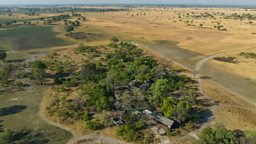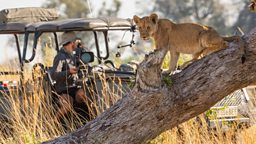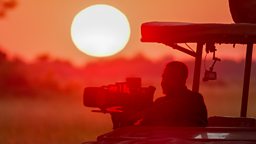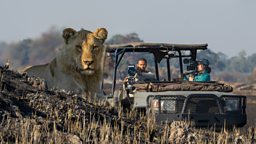Filming at night
By Assistant Producer Harry Lawrence
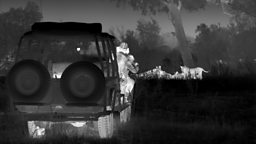
When the team first learnt that our ambition was to follow the lives of Botswana’s big cats 24 hours a day, it was beyond exciting. Seeing big cats in the daylight is incredible, but it is a rare privilege to get to follow them after dark.
Things definitely go bump in the night in the Delta!
If we were to really understand the full lives of these cats, it would be essential to film them after the sun had set.
However, following wildlife in the dark is not an easy task. Difficult terrain and thick vegetation can make it seem impossible – particularly in the Okavango Delta, where we may also need to navigate seasonal floodwaters.
We are working in proximity to predators, as well as other large animals who are active at night like hippos and elephants, so we need to keep our wits about us. Things definitely go bump in the night in the Delta!

When filming the cats, it is crucial to minimise any disturbance and avoid influencing their behaviour, so shining lights and using regular cameras isn’t an option.
We use military-grade thermal imaging cameras
Thankfully, we have some tricks up our sleeve. We use military-grade thermal imaging cameras, originally designed for surveillance, missile targeting, and astronomy instruments, which have been cleverly repurposed to be able to film the cats at night.
Only a handful of these cameras exist in the world, and unlike normal photographic video cameras, they require no light at all — instead, they use a thermal sensor to detect heat in the form of infrared wavelengths and convert this information into an electronic image.
Everything produces thermal energy — even ice — and the hotter an object is, the more energy it produces, making the body heat of big cats and other large animals stand out and appear to glow against the surrounding landscape.
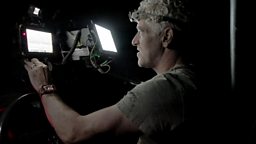
The thermal sensor can detect tiny differences in heat across a scene - usually as little as 0.01°C - and displays them as darker or lighter shades to create an image almost identical to a greyscale photograph.
At night the cats we know become emboldened by the darkness
When paired with thermal binoculars, which work in a similar way, we are able to spot, follow and film the cats throughout the night, operating in total darkness. A nocturnal stealth mission.
At night the vibrant landscape of the Delta becomes a world shrouded in mystery. Without the beating heat of the African sun, the air is cold and biting. Silence wraps everything. Our breath fogs in the air as we try to warm our gloved hands. Sudden sounds become unnerving, and the crunching of dry grass to the side of the truck makes our heads whip round just in time to see eldest lion cub, Mathata, slipping through the gloom.
At night the cats we know become emboldened by the darkness. They walk through open plains, slink past sleeping prey and even venture closer to us – unaware that we can see their heat signals on our screens. Their mood shifts and it feels like we really are near-invisible spectators – given permission to tag along for their adventures under the stars.
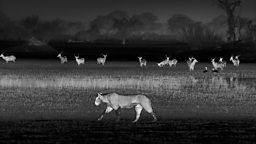
One moonless night, I stare desperately into the darkness, barely able to make out the shape of 3 lionesses loping across the plain. The thermal imaging camera finishes calibrating, and we see the group clear as day, luminous against the grass. A crowd of distant white dots at the top of the screen signifies a herd of zebra ahead of them.
lions are real masters of the night
All African big cats can be active after dusk, but lions are real masters of the night. Many people don’t know that lions are usually much more active at night than during the day. It’s thought that lions’ eyes may be six times more sensitive to light than a human’s, partially because of a light reflecting layer within them, the tapetum lucidum. Their night vision is often far beyond that of their unsuspecting prey, allowing them to use the cover of darkness to hunt.
But our “thermal eyesight” is even better, enabling us to see unbelievable details. The heat from the lions’ paws leaves temporary white footprints glowing in the dirt behind them. The grass in front of their faces glows hot white through their breath. One lioness glances up and looks back towards us, locking eyes with ours through the screen for a moment, before turning away and advancing with the hunting party.
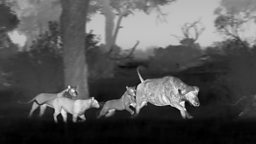
When you can see in the dark like this, it’s as if time slows down and speeds up all at once. The moments before a hunt stretch out in clear detail, but the pursuit becomes a frenzy of white across the screen as we hold our breath, desperately concentrating on capturing the unseen before it’s over in an instant.
another rare treat for us filmmakers
You might think working all night would be exhausting, but the long hours seem to flash by when the cats are active. The anticipation keeps us going until dawn – with the help of flasks of coffee and snacks stashed in the dashboard of course.
Another night we watch as Pobe, our resident cheetah, arches her back in an elongated stretch before curling up on the side of a prominent termite mound. Yawning and tucking her nose beneath the tip of her tail, she conjures the image of a lanky, but satisfied house cat. I love the nocturnal drama of a hunt, but the intimacy of watching a cheetah sleep in the dark is a marvel in itself; a rare moment of peace and stillness for the fastest animal on Earth. And another rare treat for us filmmakers.

Lions hunt in water to surprise antelope
The lions wade through water in the dead of night to hunt unsuspecting lechwe antelope.
